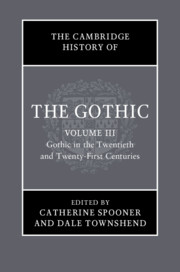Book contents
- The Cambridge History of the Gothic
- The Cambridge History of the Gothic
- The Cambridge History of the Gothic
- Copyright page
- Contents
- Figures
- Notes on Contributors
- Acknowledgements
- Introduction: A History of Gothic Studies in the Twentieth and Twenty-First Centuries
- 3.1 Gothic and Silent Cinema
- 3.2 Gothic, the Great War and the Rise of Modernism, 1910‒1936
- 3.3 Gothic and the American South, 1919‒1962
- 3.4 Hollywood Gothic, 1930–1960
- 3.5 Gothic and War, 1930‒1991
- 3.6 Gothic and the Postcolonial Moment
- 3.7 Gothic and the Heritage Movement in the Twentieth and Twenty-First Centuries
- 3.8 Gothic Enchantment: The Magical Strain in Twentieth and Twenty-First-Century Anglo-American Gothic
- 3.9 Psychoanalysis and the American Popular Gothic, 1954–1980
- 3.10 Gothic and the Counterculture, 1958‒Present
- 3.11 Gothic Television
- 3.12 Gothic and the Rise of Feminism
- 3.13 Gothic, AIDS and Sexuality, 1981–Present
- 3.14 The Gothic in the Age of Neo-Liberalism, 1990‒Present
- 3.15 The Gothic and Remix Culture
- 3.16 Postdigital Gothic
- 3.17 Gothic Multiculturalism
- 3.18 Gothic, Neo-Imperialism and the War on Terror
- 3.19 Global Gothic 1: Islamic Gothic
- 3.20 Global Gothic 2: East Asian Gothic
- 3.21 Global Gothic 3: Gothic in Modern Scandinavia
- 3.22 Gothic in an Age of Environmental Crisis
- 3.23 Gothic and the Apocalyptic Imagination
- Select Bibliography and Filmography
- Index
3.14 - The Gothic in the Age of Neo-Liberalism, 1990‒Present
Published online by Cambridge University Press: 29 July 2021
- The Cambridge History of the Gothic
- The Cambridge History of the Gothic
- The Cambridge History of the Gothic
- Copyright page
- Contents
- Figures
- Notes on Contributors
- Acknowledgements
- Introduction: A History of Gothic Studies in the Twentieth and Twenty-First Centuries
- 3.1 Gothic and Silent Cinema
- 3.2 Gothic, the Great War and the Rise of Modernism, 1910‒1936
- 3.3 Gothic and the American South, 1919‒1962
- 3.4 Hollywood Gothic, 1930–1960
- 3.5 Gothic and War, 1930‒1991
- 3.6 Gothic and the Postcolonial Moment
- 3.7 Gothic and the Heritage Movement in the Twentieth and Twenty-First Centuries
- 3.8 Gothic Enchantment: The Magical Strain in Twentieth and Twenty-First-Century Anglo-American Gothic
- 3.9 Psychoanalysis and the American Popular Gothic, 1954–1980
- 3.10 Gothic and the Counterculture, 1958‒Present
- 3.11 Gothic Television
- 3.12 Gothic and the Rise of Feminism
- 3.13 Gothic, AIDS and Sexuality, 1981–Present
- 3.14 The Gothic in the Age of Neo-Liberalism, 1990‒Present
- 3.15 The Gothic and Remix Culture
- 3.16 Postdigital Gothic
- 3.17 Gothic Multiculturalism
- 3.18 Gothic, Neo-Imperialism and the War on Terror
- 3.19 Global Gothic 1: Islamic Gothic
- 3.20 Global Gothic 2: East Asian Gothic
- 3.21 Global Gothic 3: Gothic in Modern Scandinavia
- 3.22 Gothic in an Age of Environmental Crisis
- 3.23 Gothic and the Apocalyptic Imagination
- Select Bibliography and Filmography
- Index
Summary
Since the 1980s, the ubiquity of Gothic monsters across literary, filmic and televisual media indicates both a widespread need to give form to the amorphous forces that shape our lives under free market capitalism and an eschatological awareness of all that has been lost and destroyed by the dark energies of neoliberal economics. The Neoliberal Gothic, this chapter argues, adopts the conventions of the Gothic mode to indict the perpetrators of global misery while enabling us to think around our investment in the neoliberal status quo and imagine a better way of being in the world. The Neoliberal Gothic becomes, therefore, a means of both seeing and being other-wise, proffering both critique of the present and a roadmap to a future in which our cities do not lie in ruins and we do not feel hunted by dark forces that we have no power to resist. Texts under consideration include the television series: American Horror Story, (2011), Carnivàle (2003–5) and The Strain (2012–17); films Blade (1998) and Land of the Dead (2005); and Justin Cronin’s novels The Passage (2010), The Twelve (2012) and City of Mirrors (2016).
Keywords
- Type
- Chapter
- Information
- The Cambridge History of the GothicVolume 3: Gothic in the Twentieth and Twenty-First Centuries, pp. 283 - 301Publisher: Cambridge University PressPrint publication year: 2021

